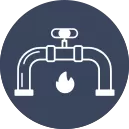Plumbing pipes are empty tubes in which liquids like water or gases can flow through a building. They contribute to supplying clean water to sinks, showers, and other fixtures, and they also carry waste water into the sewer or septic system. In some cases pipes also deliver natural gas or propane to appliances such as ovens and heaters.
Materials Used for Plumbing Pipes
There are various materials that make plumbing pipes. They all have their own pros and cons, and with so many options, they will work for different tasks.
- Copper Pipes: These are among the most popular pipes in plumbing, particularly for the water supply. Copper pipes are a rugged and strong plumbing material, and they do not corrode easily.
- PEX (Cross-Linked Polyethylene) Pipes: A sturdy plastic pipe that is commonly used to bring water throughout homes. It is extremely easy to install as it will bend around corners requiring no fittings.
- PVC (Polyvinyl Chloride) Pipes: Usually used for waste and drain systems. They are highly portable and cost effective. But they can manage only cold water and they won’t work for a hot water supply.
- CPVC (Chlorinated Polyvinyl Chloride) Pipes: These are just like PVC, but can work with hot water. These are age-old standard faucets that serve hot and cold water purposes in the average household.
- ABS (Acrylonitrile Butadiene Styrene) Pipes: ABS pipes are often used for waste, drain, and vent systems. These pipes are black and are known for their strength and resistance to impact.
- Galvanized Steel and Cast Iron Pipes: These were commonly used in older homes. The materials are sturdy, however, and are prone to rusting, which can result in leaks or limited water flow.
Different Types of Plumbing Pipes by Use
Plumbing pipes are available in all sorts of types, each designed for its own specific job. The right pipe for the job depends on whether it’s for water supply, waste lines, ventilation or even underground drainage systems.
1. Water Supply Pipes
Clean water is carried into a building by means of water supply pipes to the plumbing fixtures. Most of these pipes are commonly formed of copper, PEX or CPVC.
- Copper: A durable and corrosion-resistant material frequently applied to water-supply lines.
- PEX: PEX is becoming more and more popular because it is more flexible and easier to work with.
- CPVC: Used when you have hot water lines; it has a higher temperature tolerance.
2. Drain-Waste-Vent (DWV) Pipes
DWV pipes evacuate waste and vent gases from the building. These pipes must be strong and robust enough to accommodate waste water.
- PVC: Ideal for waste and drainage systems, PVC is lightweight, easy to install, and resistant to rot and corrosion.
- ABS: Used in DWV systems because it is strong and capable of taking a hit.
- Cast Iron: Occasionally used in DWV systems in multi-story construction for its noise reduction qualities.
3. Gas Pipes
Gas pipes transport natural gas or propane to appliances such as stoves and heaters. One common type of this tubing is black steel, which comes from the factory coated in a thin layer of epoxy to prevent corrosion.
- Black Steel: Durable, does well under pressure, is strong, and is suitable for gas lines.
- CSST: More flexible and easier to install than rigid pipes, it’s now a commonly used type of gas line.
Plumbing Pipe Sizing and Standards
Any plumbing pipe size is crucial to get the water or waste moved along. Nominal size is the approximate size of a pipe; the actual size may vary slightly. Systems vary in size, so sizes vary based on the type of fluid being flowed and the pressure in the system.
- Water Supply Pipes: These hoses or pipes are usually 1 to 2 inches in diameter.
- Waste Pipes: Drain pipes may vary in size from 1¼” to 4″ for buildings.
There are also industry standards that define the size and pressure ratings for types of pipe. These specifications assure quality and exceptional performance in plumbing systems.
Installing Plumbing Pipes
It is necessary to use proper material, proper tools, and a proper method while installing plumbing pipes. Here are a few common installation tricks.
- Cutting Pipes: The method of cutting pipes varies according to the material to be cut, and includes using a pipe cutter or a saw.
- Joining Pipes:
- Copper: Joints are usually made with soldering.
- PEX: Uses crimp, clamp, or push-fit fittings.
- PVC/CPVC/ABS: These pipes are joined using solvent cement.
- Supporting Pipes: All piping should be adequately supported to prevent excessive deflection and reduce the possibility of damage. The support interval varies according to the pipe type.
Plumbing Pipe Maintenance
The better the plumbing pipes are maintained, the longer they will last. Regular inspections for leaks, rust or defects are vital.
- Check for Leaks: Dripping pipes waste water and lead to damage.
- Look for Corrosion: Certain materials, such as galvanized steel, can corrode as the valves age, which can ultimately impact the flow of water.
- Clear Blockages: Drain pipes can get clogged with gunk, so regularly clear them.
Modern pipes, such as PEX and CPVC, might require less maintenance than before, when pipes were made of materials such as galvanized steel.
How to Choose the Right Plumbing Pipe
Here are some things to consider when it comes to choosing the right pipe:
- Purpose: Is it for water supply, waste drainage, or gas lines?
- Budget: Certain materials, such as copper, cost more than others, such as PVC.
- Durability: How long do you want the pipe to last? Some materials are more durable than others.
- Local Codes: Ensure the materials plan used is acceptable under the local planning codes.
Final Thoughts
Plumbing pipes are necessary for transporting water, waste, and gas in and out of any structure. There are all kinds of pipes like copper, PEX, PVC and CPVC, each with its own specific uses and benefits. Whether the pipes are for water supply lines, waste lines or gas lines, choosing the right kind of pipe is essential to making sure the plumbing system runs effectively and holds up over time.



